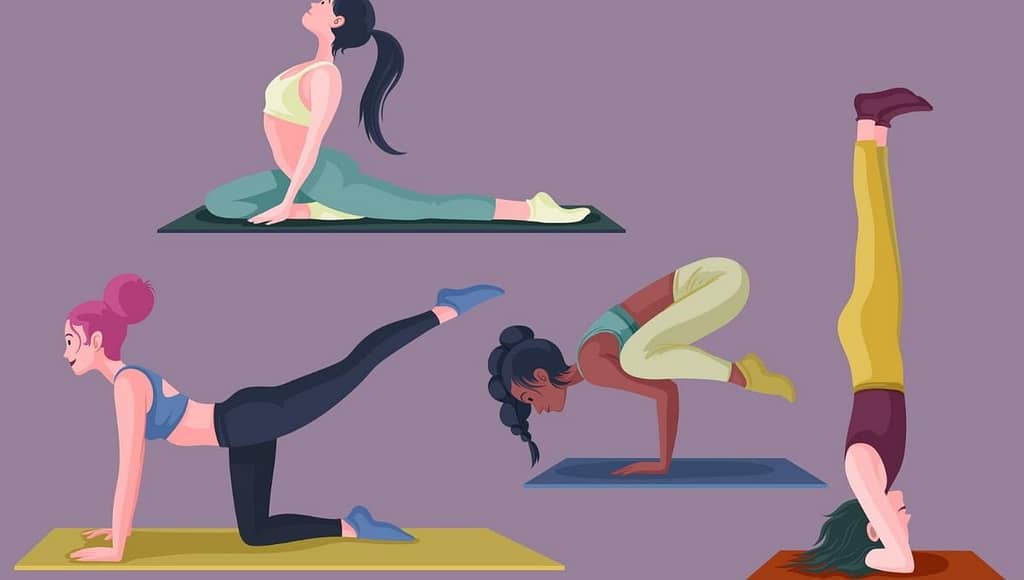How does yoga improve your quality of life : Yoga, an ancient practice and form of meditation, has gained increasing popularity in today’s fast-paced society. Yoga provides many a welcome refuge from life’s chaos – whether that means practicing downward facing dog posture on a mat in your bedroom, an ashram in India or New York’s Times Square! Furthermore, practicing yoga also brings many other mental and physical health benefits – some even reach into the kitchen table!
See More : Which direction is best for doing yoga?
How does yoga improve your quality of life
Types of yoga
There are various kinds of yoga; Hatha (an amalgamation of many styles) is one of the more widely practiced styles. This form of physical, rather than still and meditative yoga focuses on pranayamas (breath-control exercises), followed by asanas (yoga postures), culminating in savasana (restful rest). How does yoga improve your quality of life
Yoga practice should challenge and yet not overwhelm. Once at this “edge”, focus should remain on breath while mind remains accepting and serene.

A better body image
Yoga enhances inner awareness. It focuses on your current abilities as they pertain to breath and strength of both body and mind; not physical appearance!
Yoga studios typically don’t feature mirrors to encourage participants to focus their awareness inward, rather than the pose (or people around them) they’re doing. Studies have found that those who practiced yoga were more aware of themselves than non-practitioners, were happier with and less critical of their bodies, thus contributing significantly to treatment programs for eating disorders as well as programs promoting positive body image and self-esteem. For this reason, yoga has become an integral component in such programs and treatments for eating disorders alike.
Becoming a mindful eater

Mindfulness involves paying attention to what’s happening around us without judgement, without judgment of yourself or others. How does yoga improve your quality of life
Yoga practice has been proven to increase mindfulness not just in class, but across a person’s entire life. How does yoga improve your quality of life
Researchers define mindful eating as being aware of both physical and emotional sensations associated with eating in an objective and nonjudgmental way. A questionnaire was devised to measure mindful eating using these behaviors:
Disinhibition refers to eating even when full (overeating); being aware of how food looks, tastes and smells; responding to environmental cues like the sight or smell of food as prompts for eating (epidemiological eating); or emotionally eating when sad or stressed (emotional overeating). How does yoga improve your quality of life
Researchers found that people who practiced yoga were more mindful eaters, according to their scores. Both years and minutes of practice per week were linked with higher mindful eating scores. Yoga helps practitioners become more attuned with how their bodies feel – something which carries over into mealtime as you enjoy each bite or sip with full awareness of its smell, taste, texture, temperature and feeling in your mouth.
A boost to weight loss and maintenance

People who practice yoga and are mindful eaters tend to be more in tune with their bodies and more aware of hunger cues and feelings of fullness.
Researchers discovered that people who practiced yoga for at least four years for at least 30 minutes once every week gained less weight during middle adulthood, and those who were overweight actually saw weight loss. Overall, those who practiced yoga had lower BMIs compared with those who did not, which they attribute to mindfulness: mindful eating can create more positive relationships with food and eating habits.
Enhancing fitness

Yoga is well known for its ability to soothe tension and anxiety in both mind and body. But yoga may also have an impact on one’s exercise capacity.
Researchers conducted a small-group yoga study with individuals who had never participated before and found that after eight weeks of practicing twice weekly for 180 minutes total over eight weeks, participants experienced improved muscle strength, endurance, flexibility and cardiorespiratory fitness.
Cardiovascular benefits

Studies of yoga’s benefits on cardiovascular risk factors have yielded positive findings: yoga helped lower blood pressure for people suffering from hypertension. It appears to restore baroreceptor sensitivity allowing your body to sense when changes in blood pressure arise and maintain equilibrium more easily.
Another study concluded that practicing yoga helped healthy patients and those diagnosed with coronary artery disease to achieve improved lipid profiles, reduced excessive blood sugar levels and reduced medications used for non-insulin dependent diabetes, as well as decreasing dependence on medications altogether. As such, yoga is now being included as part of cardiac rehabilitation programs because of its cardiovascular and stress relieving benefits. How does yoga improve your quality of life
Before embarking on any exercise program, always consult your physician first.
Researchers are conducting studies to see whether yoga can assist those struggling with depression and arthritis as well as increase survival from cancer.
Yoga improves physical strength, balance and flexibility

Yoga doesn’t require being flexible to start practicing; in fact it makes us flexible! Yoga poses and breathwork increase blood flow to increase flexibility while at the same time warm up muscles for warmer weather activities; holding poses builds strength. Stronger muscles means improved resilience against arthritis or back pain conditions as well as healthy ageing processes. How does yoga improve your quality of life
Improved flexibility will enable you to gradually practice postures more efficiently. Aches and pains should gradually fade, tight hips will gradually open up, poor posture is corrected as tight hamstrings ease tightness around lumbar spine, leading to pain; inflexibility muscles cause poor posture; with regular yoga practice mobility also improves. Over time one’s ligaments, tendons and even mental resolve also become stronger resulting in stronger mental resolve as mental strength also grows stronger over time.
Yoga helps you manage pain

Physical and mental strength help one manage pain more effectively. Yoga provides one effective tool to alleviate it; studies have proven this. Yoga postures reduce discomfort for people suffering from various medical conditions; yoga also assists body alignment to deliver relief to back, neck, joints and muscles pain relief. When we feel better physically we show up more fully in life. How does yoga improve your quality of life
Yoga improves lung health

Breathing practices and asanas that open the heart, chest and lungs improve respiratory health. Muscles become stronger while breathing patterns are corrected – helping rid unwanted particles out. Mindfulness improves to allow better and fuller breathing as posture correcting provides further benefits – posture correction also allows better airflow for enhanced breathing – pranayama or breathing exercises allow participants to control the breath while relieving stress and toxins through pranayama exercises or controlling one’s own breath control capabilities. How does yoga improve your quality of life
Yoga de-stresses you and helps you sleep better

Yoga practices provide an effective means of relieving anxiety and insomnia through relaxation practices that focus on relaxing the “monkey mind,” switching off from daily tasks and activities and getting restful night’s rest. A few poses like corpse pose, reclined spinal twist and legs up on wall pose are known to relieve tension from daily stressors while aiding restful slumber – according to National Institutes of Health evidence shows how yoga supports stress management, mental wellbeing, mindful eating practices, weight management as well as quality restful slumber.
Yoga’s effect on managing stress is immense. With deep breathing and relaxation techniques, it helps lower cortisol levels while simultaneously balancing nervous systems and activating parasympathetic ones to activate parasympathetic ones – leading to decreased blood pressure, heart rate and heart rate monitor readings; improved digestion; immune support benefits as well as managing symptoms related to anxiety depression fatigue asthma or insomnia. How does yoga improve your quality of life
Yoga helps us become present, aware of bodily sensations and our breath; this allows for improved decision-making, productivity and the ability to manage situations effectively; it makes us calmer, adaptable, less reactive. How does yoga improve your quality of life
Yoga energizes you
Practice yoga to relieve tension and release blockages that accumulate throughout your body, enhance prana (vital life force), and infuse energy back into your system, increasing alertness and enthusiasm while decreasing negative feelings. Yoga class leaves you feeling refreshed and energetic compared to gym workouts which often leave you exhausted and unhappy after each session. How does yoga improve your quality of life
Cultivates compassion and kindness
Yoga has an immense effect on us as people. By helping to reduce stress levels and create feelings of joy and wellbeing, it allows us to become more positive, compassionate and accepting towards ourselves and others – approaching people or situations without negativity in mind. Yoga also reduces feelings of loneliness or isolation – especially if we join group classes where there will likely be similar people!
Yoga offers many additional positive aspects that will contribute to improving your lifestyle: healthy weight loss, better routine and habits, mindful eating practices, immunity benefits and enhanced productivity and focus. etc. How does yoga improve your quality of life
Yoga helps in relieving anxiety
Yoga practice emphasizes being present in the moment and finding peace and equilibrium for body and mind. By including it as part of your daily routine, incorporating it can help relieve negative feelings of anxiety while encouraging an overall more holistic lifestyle. Yoga may even assist in dealing with post-traumatic stress disorder (PTSD).
Yoga can help reduce pain
Harvard Medical School conducted a study which proved yoga to be beneficial in alleviating arthritis, fibromyalgia, migraine, low back pain and other forms of chronic pain conditions. Not only can yoga improve psychosocial wellbeing but it can also bring physical comfort. Daily practicing of yoga may even improve daily function among those suffering from osteoporosis-related curvatures of spine; furthermore yoga moves can increase flexibility and muscle function – ultimately relieving any ongoing chronic discomfort you may be feeling. How does yoga improve your quality of life
Yoga helps keep your heart healthy
Over recent years, more scientists and cardiovascular specialists are beginning to recognize and endorse yoga for its benefits on cardiovascular health. Regular practice of yoga may help lower your blood pressure, cholesterol levels and glucose heart rates – helping keep the heart happier overall. How does yoga improve your quality of life
Most cardiovascular disease can be directly attributed to lifestyle choices; thus yoga practice for 60 minutes daily may help protect you against such health threats and help ensure a happy heart is key in living an enjoyable and full life. Peace of mind comes from having health insurance against critical illnesses; specifically heart disease coverage may provide just what’s necessary here. A policy focused on this specific area could provide exactly that protection. On International Yoga Day, consider purchasing the necessary health insurance plan that offers comprehensive coverage against cancer and heart diseases suited specifically for your requirements. When buying, protect yourself against critical illnesses by getting yourself protected with adequate protection!
Yoga can improve your quality of life
Yoga practice can significantly enhance your quality of life overall by helping to enhance sleep, alleviate mood issues, and combat signs of fatigue. Studies show how yoga helps enhance quality sleep for greater productivity and social activity – not to mention spiritual well-being! How does yoga improve your quality of life
As people around the globe recognize and celebrate the benefits of yoga on International Day of Yoga, make a promise to incorporate its practice into your everyday life as part of your own stress relief plan and journey towards greater wellbeing and fulfillment. Yoga could help lead you down a path towards peace of mind, relaxation and wellbeing – so take part! How does yoga improve your quality of life
FAQs
How does yoga improve quality of life?
Regular yoga practice may reduce stress levels and inflammation levels across the body, contributing to healthier hearts. Many factors contributing to heart disease – high blood pressure and excess weight among them – can also be addressed through yoga practice.
What effect does yoga have on lifestyle?
Lifestyle factors, including consumption of tobacco and alcohol, diet and physical activity are closely tied to numerous chronic health conditions including cancer, diabetes, obesity and cardiovascular disease.
What are the 5 main benefits of yoga?
Yoga offers numerous physical advantages that include increased flexibility and muscle strengthening and toning; improved respiration, energy levels and vitality; weight reduction through controlled metabolism and control over food portions; cardio and circulatory health improvements as well as athletic performance enhancement and protection from injuries; as well as keeping stress at bay.
How does yoga change your life?
Yoga helps you learn to control your breathing, leading to relaxation and peace in both body and mind. Regular practice improves cognitive functions that allow for enhanced concentration and memory retention; sharpening focus, increasing clarity of thought.
How yoga works as a lifestyle?
Yoga helps us relieve nervousness, improve health and concentration in our minds and lowers blood pressure simultaneously. Yoga also can treat various emotional and mental conditions including anxiety, depression and mood swings as well as helping blood circulation throughout our bodies by decreasing pressure on blood vessels and increasing flow.


